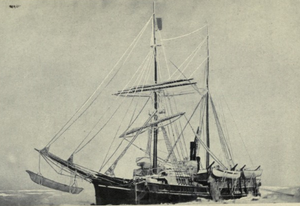
The last voyage of the Karluk, flagship of the Canadian Arctic Expedition of 1913–16, ended with the loss of the ship in the Arctic seas, and the subsequent deaths of nearly half her complement of 25.
In August 1913, Karluk, a brigantine formerly used as a whaler, became trapped in the ice while sailing to a rendezvous point at Herschel Island. After a long drift across the Beaufort and Chukchi seas, in January 1914 the ship was crushed and sunk. In the ensuing months, the crew and expedition staff struggled to survive, first on the ice and later on the shores of Wrangel Island. In all, eleven men died before rescue.
The Canadian Arctic Expedition was organised under the leadership of Canadian anthropologist Vilhjalmur Stefansson, and had both scientific and geographic purposes. Shortly after Karluk was trapped, Stefansson left the ship with a small party, claiming that he intended to hunt for caribou. The ice then carried Karluk westwards. Upon reaching land Stefansson devoted himself to the expedition's scientific objectives, leaving the crew and staff on board the ship to their own devices under the charge of its captain, Robert Bartlett. After the sinking, Bartlett organised a march across the ice to Wrangel Island, 80 miles (130 km) away.[n 1] Conditions were difficult and dangerous; two four-man parties were lost before the island was reached.
From the island, Bartlett and an Inuk companion, Kataktovik, set out across the frozen sea for the Siberian coast, in search of help. Assisted by local populations, the pair eventually reached Alaska, but sea ice conditions prevented any immediate rescue mission. On Wrangel Island, the stranded party survived by hunting game, but were short of food and troubled by internal dissent. Before their eventual rescue in September 1914, three more of the party had died, two of illness and one in violent circumstances; 14 were rescued.
Historians have divided views on Stefansson's decision to leave the ship. Some of the voyage's survivors were critical of his seeming indifference to their ordeal and the loss of their comrades. He escaped official censure, and was publicly honoured for his later work on the expedition despite the Canadian government's reservations about its overall management. Although Bartlett was criticised by an admiralty commission for taking Karluk into the ice, he was hailed as a hero by the public and by his former Karluk shipmates.
Cite error: There are <ref group=n> tags on this page, but the references will not show without a {{reflist|group=n}} template (see the help page).